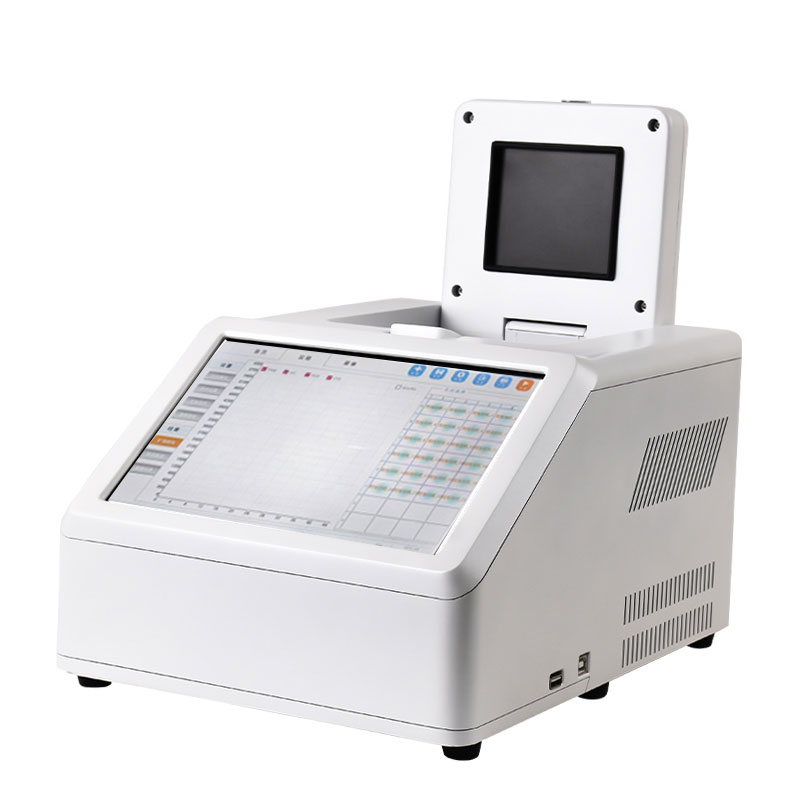Tianqiong Sensor IOT Technology Co., Ltd
Sales Manager:Ms. Emily Wang
Cel,Whatsapp,Wechat:+86 15898932201
Email:info@fengtutec.com
Add:No. 155 Optoelectronic Industry Accelerator, Gaoxin District, Weifang, Shandong, China

Sales Manager:Ms. Emily Wang
Cel,Whatsapp,Wechat:+86 15898932201
Email:info@fengtutec.com
Add:No. 155 Optoelectronic Industry Accelerator, Gaoxin District, Weifang, Shandong, China

Model:FT-CW48H
Brand:tianqiong
fluorescent quantitative PCR instrument basic structure
fluorescent quantitative PCR instrument is specially designed for the needs of rapid nucleic acid testing in clinical, food, environmental and research applications.fluorescent quantitative PCR instrument is a real-time detection instrument, mainly composed of a gene amplification thermal circulation system, a fluorescence real-time detection system, a microcircuit control system, a computer and application software. Two of the core functional modules are: the thermal circulation system and the fluorescence real-time detection system. Among them, the working principle of the gene amplification thermal cycle system is basically the same as that of the traditional gene amplification instrument, and the thermal cycle process is completed by semiconductor heating and refrigeration. The fluorescence detection system mainly consists of fluorescence excitation components, optical signal transmission components, fluorescence detection components, and control systems.
fluorescent quantitative PCR instrument technical indicators
The "///" symbol indicates that the national standard currently does not define this indicator or mandatory requirement.
| Metric Name | CW16H | CW32H | CW48H | |
| Appearance | ||||
| External dimensions | 235mm*385mm*175mm (width*deep*height) | |||
| weight | 5.6kg | 5.7kg | 5.8Kg | |
| Electrical parameters | ~220V/50Hz, 255W | |||
| Data interface | USB 2.0 *2 (two on the right) | |||
| Environment parameters | ||||
| Running conditions | Temperature: 10-30℃, humidity: 20%~80% | |||
| Transportation and storage conditions | Temperature: -20~55℃, humidity: 20%~80% | |||
| Altitude | <2500 meters | |||
| Noise level | A weight, <60dB | |||
| Sample parameters | ||||
| Sample capacity | 16*0.2mL | 32*0.2mL | 48*0.2mL | |
| Test tube type | Single tube, eight-line test tube | |||
| Sample volume | 15-100uL | |||
| Temperature characteristics | ||||
| Heating/cooling method | Semiconductor heating/refrigeration | |||
| Temperature range | 4℃-99℃ | |||
| Maximum heating rate | ≥3.5℃/s | |||
| Average heating rate | ≥2.5℃/s | |||
| Maximum cooling rate | ≥3.5℃/s | |||
| Average cooling rate | ≥2.5℃/s | |||
| Temperature control accuracy | ≤±0.01℃ | |||
| Temperature accuracy | ≤±0.1℃ | |||
| Temperature uniformity | ≤±0.3℃ | |||
| Optical properties | ||||
| Number of fluorescence detection channels | 4 channels | |||
| Light emitting devices | High brightness LED | |||
| Lighting devices | High sensitivity, high signal-to-noise ratio photodiode | |||
| Adapt probe or dye | First channel: 470/520 FAM, SYBR Green | |||
| Second channel: 530/570 HEX, JOE, VIC | ||||
| Third channel: 580/610 ROX, CY3.5, Texas-Red | ||||
| Channel 4: 630/670 CY5 | ||||
| Detection sensitivity | 1 copy | |||
| Linear detection range | 100~1010 copies | |||
| Linear correlation coefficient | ≥0.999 | |||
| Channel cross-talk | No cross-talk | |||
| Detect repeatability | ≤1.0% | |||
fluorescent quantitative PCR instrument main application fields
Foodborne pathogenic bacteria detection
Food Safety
Animal and plant origin detection
Plant Science and Agricultural Biotechnology
Gene mutations and polymorphisms
Animal Blight
Basic scientific research
Water monitoring
Pathogen nucleic acid detection
Genetically modified test
Animal epidemic monitoring
Food hygiene quarantine
Customs import and export quarantine
In the road traffic environment safety monitoring system, the Laser Snow Depth Monitor, especially in areas with frequent snowfall in winter, can accurately and real-time monitor the depth of snow on the road surface. It provides key data for traffic management departments, helping to ensure road sa...
Water quality monitoring micro-station is a new type of online monitoring product for environmental protection and water conservancy fields. It can real-time monitor parameters such as dissolved oxygen, turbidity, and pH in rivers, lakes, and reservoirs, and features automatic monitoring and data uploading functions, meeting the needs of high-density deployment....
A School Weather Station is a comprehensive device established on campus that can automatically, continuously, and in real-time observe and record various meteorological elements. Composed of sensors, data loggers, power supply systems, communication modules, and data display platforms (such as camp...
Meteorological disasters often cause severe losses to agriculture. Among the numerous agrometeorological disasters, drought, flood, frost, and dry-hot wind are relatively common.Drought is a disaster caused by long-term lack of rain or little rain, which leads to soil water shortage and dry air, res...